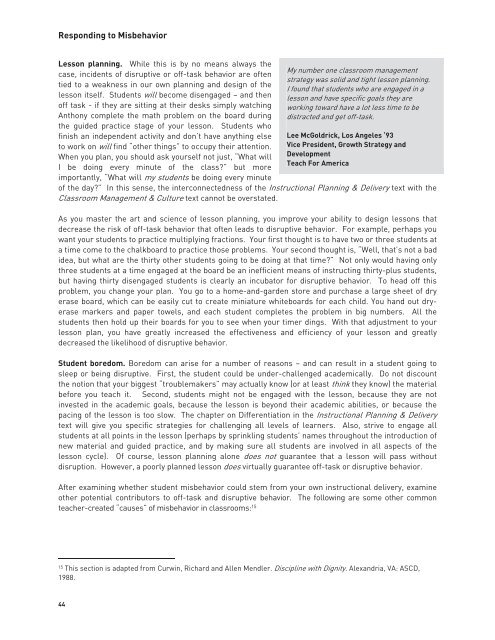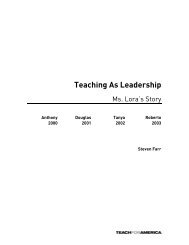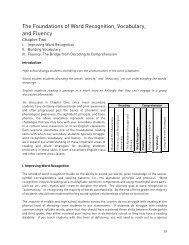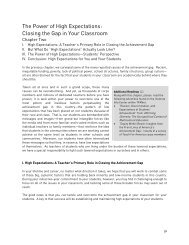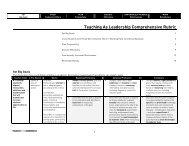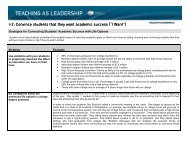Responding to Misbehavior - Teaching As Leadership
Responding to Misbehavior - Teaching As Leadership
Responding to Misbehavior - Teaching As Leadership
Create successful ePaper yourself
Turn your PDF publications into a flip-book with our unique Google optimized e-Paper software.
<strong>Responding</strong> <strong>to</strong> <strong>Misbehavior</strong><br />
Lesson planning. While this is by no means always the<br />
case, incidents of disruptive or off-task behavior are often<br />
tied <strong>to</strong> a weakness in our own planning and design of the<br />
lesson itself. Students will become disengaged – and then<br />
off task - if they are sitting at their desks simply watching<br />
Anthony complete the math problem on the board during<br />
the guided practice stage of your lesson. Students who<br />
finish an independent activity and don’t have anything else<br />
<strong>to</strong> work on will find “other things” <strong>to</strong> occupy their attention.<br />
When you plan, you should ask yourself not just, “What will<br />
I be doing every minute of the class?” but more<br />
importantly, “What will my students be doing every minute<br />
of the day?” In this sense, the interconnectedness of the Instructional Planning & Delivery text with the<br />
Classroom Management & Culture text cannot be overstated.<br />
<strong>As</strong> you master the art and science of lesson planning, you improve your ability <strong>to</strong> design lessons that<br />
decrease the risk of off-task behavior that often leads <strong>to</strong> disruptive behavior. For example, perhaps you<br />
want your students <strong>to</strong> practice multiplying fractions. Your first thought is <strong>to</strong> have two or three students at<br />
a time come <strong>to</strong> the chalkboard <strong>to</strong> practice those problems. Your second thought is, “Well, that’s not a bad<br />
idea, but what are the thirty other students going <strong>to</strong> be doing at that time?” Not only would having only<br />
three students at a time engaged at the board be an inefficient means of instructing thirty-plus students,<br />
but having thirty disengaged students is clearly an incuba<strong>to</strong>r for disruptive behavior. To head off this<br />
problem, you change your plan. You go <strong>to</strong> a home-and-garden s<strong>to</strong>re and purchase a large sheet of dry<br />
erase board, which can be easily cut <strong>to</strong> create miniature whiteboards for each child. You hand out dryerase<br />
markers and paper <strong>to</strong>wels, and each student completes the problem in big numbers. All the<br />
students then hold up their boards for you <strong>to</strong> see when your timer dings. With that adjustment <strong>to</strong> your<br />
lesson plan, you have greatly increased the effectiveness and efficiency of your lesson and greatly<br />
decreased the likelihood of disruptive behavior.<br />
Student boredom. Boredom can arise for a number of reasons – and can result in a student going <strong>to</strong><br />
sleep or being disruptive. First, the student could be under-challenged academically. Do not discount<br />
the notion that your biggest “troublemakers” may actually know (or at least think they know) the material<br />
before you teach it. Second, students might not be engaged with the lesson, because they are not<br />
invested in the academic goals, because the lesson is beyond their academic abilities, or because the<br />
pacing of the lesson is <strong>to</strong>o slow. The chapter on Differentiation in the Instructional Planning & Delivery<br />
text will give you specific strategies for challenging all levels of learners. Also, strive <strong>to</strong> engage all<br />
students at all points in the lesson (perhaps by sprinkling students’ names throughout the introduction of<br />
new material and guided practice, and by making sure all students are involved in all aspects of the<br />
lesson cycle). Of course, lesson planning alone does not guarantee that a lesson will pass without<br />
disruption. However, a poorly planned lesson does virtually guarantee off-task or disruptive behavior.<br />
After examining whether student misbehavior could stem from your own instructional delivery, examine<br />
other potential contribu<strong>to</strong>rs <strong>to</strong> off-task and disruptive behavior. The following are some other common<br />
teacher-created “causes” of misbehavior in classrooms: 15<br />
15 This section is adapted from Curwin, Richard and Allen Mendler. Discipline with Dignity. Alexandria, VA: ASCD,<br />
1988.<br />
44<br />
My number one classroom management<br />
strategy was solid and tight lesson planning.<br />
I found that students who are engaged in a<br />
lesson and have specific goals they are<br />
working <strong>to</strong>ward have a lot less time <strong>to</strong> be<br />
distracted and get off-task.<br />
Lee McGoldrick, Los Angeles ‘93<br />
Vice President, Growth Strategy and<br />
Development<br />
Teach For America


